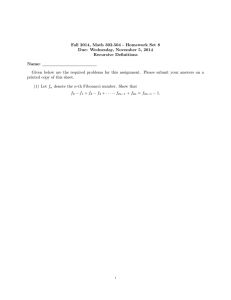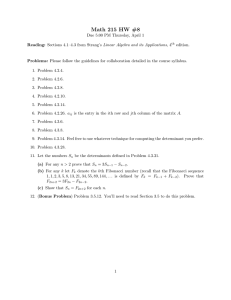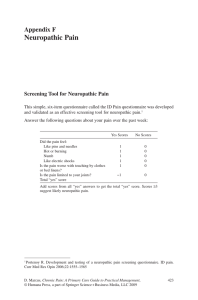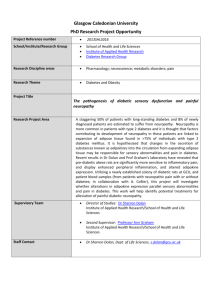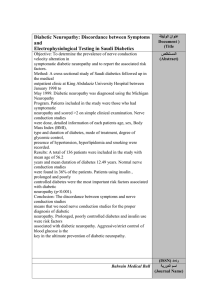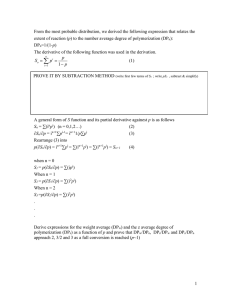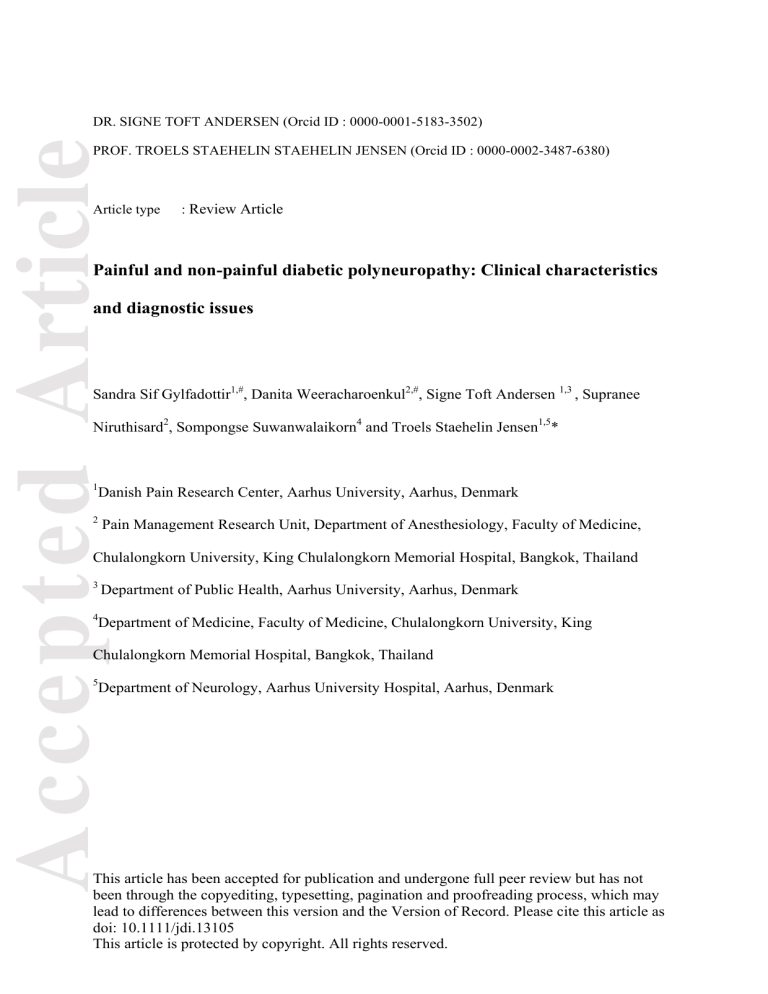
Accepted Article DR. SIGNE TOFT ANDERSEN (Orcid ID : 0000-0001-5183-3502) PROF. TROELS STAEHELIN STAEHELIN JENSEN (Orcid ID : 0000-0002-3487-6380) Article type : Review Article Painful and non-painful diabetic polyneuropathy: Clinical characteristics and diagnostic issues Sandra Sif Gylfadottir1,#, Danita Weeracharoenkul2,#, Signe Toft Andersen 1,3 , Supranee Niruthisard2, Sompongse Suwanwalaikorn4 and Troels Staehelin Jensen1,5* 1 2 Danish Pain Research Center, Aarhus University, Aarhus, Denmark Pain Management Research Unit, Department of Anesthesiology, Faculty of Medicine, Chulalongkorn University, King Chulalongkorn Memorial Hospital, Bangkok, Thailand 3 Department of Public Health, Aarhus University, Aarhus, Denmark 4 Department of Medicine, Faculty of Medicine, Chulalongkorn University, King Chulalongkorn Memorial Hospital, Bangkok, Thailand 5 Department of Neurology, Aarhus University Hospital, Aarhus, Denmark This article has been accepted for publication and undergone full peer review but has not been through the copyediting, typesetting, pagination and proofreading process, which may lead to differences between this version and the Version of Record. Please cite this article as doi: 10.1111/jdi.13105 This article is protected by copyright. All rights reserved. *Correspondence: Professor Troels Staehelin Jensen Accepted Article Danish Pain Research Center Aarhus University Hospital Palle Juul-Jensens Boulevard 1 DK-8200 Aarhus N, Denmark Tel.: +45 9350 8575 E-mail address: tsjensen@clin.au.dk # Both authors contributed equally to this work. Short running title: Diagnostic issues in diabetic neuropathy Abstract Diabetic neuropathy is a common complication of diabetes and can be either painful or nonpainful. It is challenging to diagnose this complication, since no biomarker or clear consensus on the clinical definition of either painful or non-painful diabetic neuropathy exists. Hence, a hierarchical classification has been developed categorizing the probability of the diagnosis into: possible, probable or definite, based on the clinical presentation of symptoms and signs. Pain is a warning signal of tissue damage, and non-painful diabetic neuropathy therefore represents a clinical and diagnostic challenge because it often goes unnoticed until irreversible nerve damage has occurred. Simple clinical tests seems to be the best for evaluation of diabetic neuropathy in the general care for diabetes. Screening programs at regular intervals may be the most optimal strategy for early detection and interventions to possibly prevent further neuronal damage and to lower the economic burden of this complication. Keywords: Diabetic neuropathy; Diagnosis; Clinical characteristics This article is protected by copyright. All rights reserved. Introduction Accepted Article Diabetes and its complications represent major and increasing challenges to healthcare systems worldwide. According to the International Diabetes Federation (IDF), 425 million people worldwide aged 20 years or above had diabetes in 2017, and this number is expected to increase to 629 million by 20451. This development also applies to developing countries, for example, Asia where there has been a dramatic increase in diabetes prevalence2. According to the IDF, it is estimated that 82 million adults have diabetes in South East Asia1. Diabetic neuropathy (DN) represents a common, disabling and until recently a largely neglected problem affecting around 50% of patients with diabetes at some point 3-6. A major problem with DN is that once it has developed and been complicated by, for example, ulcers and Charcot foot, it is difficult to reverse, and patients face an increased risk of amputations associated with increased mortality7-10. It is therefore essential to detect symptoms or signs of DN as early as possible to implement interventions with a possibility of avoiding further neuronal damage. This has been stressed in several previous reviews 4,5,7,8,10,11 . However, the detection of DN is challenging in clinical practice due to the lack of a clear consensus for the definition and optimal clinical assessments to diagnose DN6,12,13. Similar differences have been encountered for pain, where the criteria for neuropathic pain has also varied considerably 14,15. This review will address the clinical characteristics of painful and non-painful DN and the possibilities for diagnosing these conditions. Since the majority of patients with type 2 diabetes are treated in general practice, we focus on proposals for simple assessments of DN outside specialized hospital clinics. This article is protected by copyright. All rights reserved. Definitions and classification of diabetic neuropathy Accepted Article The phenotype of DN is heterogeneous. The most common form of DN is a chronic symmetrical length-dependent sensorimotor polyneuropathy, termed diabetic polyneuropathy (DPN), which accounts for 75-90% of all DN cases. Other types of DN include autonomic neuropathy, diabetic radiculoplexopathy (formerly called diabetic amyotrophy), mono-neuropathies and treatment-induced neuropathies (Figure 1 and Table 1)4,12,16. In the following, we will focus on DPN, which can be either painful (PDPN) or non-painful. DPN is among other factors attributable to hyperglycemia, hyperglycemia-associated metabolic derangement, dyslipidemia and microvessel alterations17. A broad and simple definition of DPN is ”the presence of symptoms and/or signs of peripheral nerve dysfunction in people with diabetes after the exclusion of other causes” 6. According to the International Association for the Study of Pain neuropathic pain is pain caused by a lesion or disease of the somatosensory system14. Along these lines, painful DPN (PDPN) can be defined as “pain caused by a lesion of the somatosensory system attributable to diabetes”. The minimal criteria for diabetic neuropathy - whether painful or non-painful have, however, been a matter of debate for decades. The inconsistency in the definition used for DPN is reflected by varying prevalence-estimates of this condition 10,12,18,19, 20. Clinical characteristics of non-painful DPN The development of DPN is insidious, usually starting in the toes and under the feet and gradually ascending up in the leg. When the symptoms have reached knee level, they usually start to occur in fingertips progressing further up in the hands and arms reflecting the “dyingback” progression of neuronal damage. Patients eventually present with a characteristic “stocking-glove” like distribution of neuronal dysfunction (Figure 1)4,21-23. Consistent with the length dependent character of DPN there may even be affection of the distal nerve end- This article is protected by copyright. All rights reserved. ings and intercostal nerves giving rise to a “daggert type” of sensory pattern. The temporal Accepted Article course of nerve fiber damage of different nerve fiber types in DPN is not clear. It is claimed that the most early symptoms in DPN reflect early involvement of small fibers. Subsequently the neuronal damage is proposed to progress to include large fiber dysfunction6. Small fiber involvement is usually painful, but may also give rise to negative symptoms with selective loss of temperature- and pain sensation. Large fiber dysfunction is characterized by numbness, “walking on wool” or a feeling as if the foot is “wrapped in paper”. With large fiber dysfunction the gait may be unsecure, either wide-based or high stepping, and hold an increased risk of falls. In DPN small- and large fiber dysfunction are most commonly coexisting, and a clinical presentation with combinations of large- and small fiber symptoms such as numbness, painful sensations, gait abnormalities and postural instability. However, since long prospective studies are scarce, no clear evidence exist for the proposed temporal course of neuronal dysfunction. We recently performed a prospective study assessing this proposed temporal involvement of nerve fiber types in DPN, but found no evidence for this proposed hypothesis (Laura Linnea Määttä, personal communication). In DPN, the character of symptoms and signs are broadly divided into so-called “negative” and “positive” symptoms20,24,25. Negative symptoms are often described as numbness or a feeling of reduced sensation when walking: “It is like walking on cotton or foam”. Symptoms start slowly and the unnoticeable loss of sensory function often remains unrecognized until irreversible nerve damage has occurred25,26. Positive symptoms range from non-painful to painful symptoms25. Paresthesia are non- painful sensations that are often described as tingling, prickling, or ant-like sensations. At other times it may feel like a pressing feeling, as if the foot is “squeezed into an unfitting shoe”, and the patient may have difficulty distinguishing between non-painful and painful This article is protected by copyright. All rights reserved. sensations. In most cases, symptoms are confined to the skin, but sometimes felt more deep- Accepted Article ly. Signs of DPN include a reduced sensation to different sensory modalities involving small fibers (temperature and pinprick) and large fibers (vibration, position and cutaneous direction sense)23. The sensory loss overlaps partly or completely with symptoms, i.e., the localization of sensory abnormalities also has a “stocking glove”-like distribution. Clinical characteristics of painful diabetic neuropathy (PDPN) Pain represents a particular problem in PDPN because it is associated with reduced quality of life and may compromise rehabilitation 27.28 . Pain in PDPN can be neuropathic or non- neuropathic (i.e., related or unrelated to the neuropathy). The non-neuropathic types of pain include various types of musculoskeletal pain outside the foot and leg area. Non-neuropathic foot pains may coexist with DPN and can be caused by, for example, peripheral artery disease, arthritis, spinal stenosis, local foot problems and other neuropathies. It can be difficult to distinguish non-neuropathic pain from pain due to neuropathy per se. Neuropathic pain, whether caused by DPN, spinal cord injury or stroke, is located within the territory of the sensory abnormality and may occupy the entire area of sensory abnormality or only a fraction of it14,29,30. This clinical pattern is different from those pains that are not associated with a specific nerve injury, where the pain distribution does not correspond to the innervation territory of a specific nerve, nerve root, group of fascicles or a segmental dermatome14,21,24. Neuropathic pains are in general of two types: spontaneous and evoked pain21,23,24. Spontaneous pains come in different forms: They can be shooting, shock-like, aching, cramping, crushing, smarting or burning, and the pain can be present constantly or intermittently. In DPN, patients may describe their pain as unpleasant pricking or sticking sensations in the feet and toes. Evoked types of pain include allodynia (= painful sensations elicited by non-painful This article is protected by copyright. All rights reserved. stimuli) and hyperalgesia (= increased pain response by otherwise painful stimuli), which are Accepted Article both common in certain types of neuropathic pain, but considered to be relatively rare in DPN. Differences and similarities between PDPN and DPN There has been an emerging interest in the potential differences in risk factors of PDPN and DPN and the underlying pathogenesis of these conditions. Risk factors of both PDPN and DPN have recently been elegantly reviewed by Spallone and Greco31. They stated female gender, smoking, older age, overweight and a longer duration of diabetes as risk factors for both PDPN and DPN31. However, findings regarding older age and female sex as risk factors for PDPN and DPN are inconsistent in other studies32. As pointed out by Spallone and Greco31, previous studies have been heterogeneous in their design, study populations and applied definitions of DPN, rendering it difficult to compare risk factors across studies. Also, inconsistent findings for an association between pain and neuropathy severity exists31. Recently, three large cross-sectional studies, a British33, a German-Czech34 and an Italian13 one have been conducted using comprehensive clinical evaluations of DPN including quantitative sensory testing (QST), skin biopsies (small nerve fiber quantitation), nerve conduction studies and a general neurological evaluation. The definitions of DPN and PDPN as well as the study design were fairly similar in the 3 studies and the population consisted mostly of patients with type 2 diabetes. They identified only few and non-consistent differences in risk factors between PDPN and non-painful DPN. The British Pain In Neuropathy Study (PiNS) aimed to identify sensory phenotypes of patients with PDPN and DPN33. The study included 191 patients and DPN was defined as symptoms or signs of DPN together with abnormal nerve conduction velocity or abnormal intra-epidermal nerve fiber density. PDPN was defined according to IASP’s definition of This article is protected by copyright. All rights reserved. neuropathic pain15,26. This study showed no difference between PDPN and DPN regarding Accepted Article sex, age, BMI and waist-hip circumference. Patients with moderate to severe PDPN had higher HbA1c levels and were younger compared to those with mild PDPN or DPN. In addition, they found pain being correlated with more severe DPN33. In contrast, the Italian multicenter study of 816 diabetes patients of both type 1 and type 2 diabetes found female sex to be a risk factor for PDPN using the same definition of PDPN and DPN as the PiNS study13. They showed that patients with type 2 diabetes had a higher risk of neuropathy compared with patients with type 1 diabetes. In addition, higher BMI, longer diabetes duration, and higher HbA1c levels were risk factors for both PDPN and DPN13. Raputova et al.34 studied 232 patients with DPN and showed that female sex was a risk factor for PDPN and more severe DPN. The PiNS study evaluated clinical characteristics of sensory dysfunction and the rela- tionship between signs and symptoms in PDPN and DPN using QST and structural neurological examinations. Patients with PDPN had more pronounced neuronal abnormalities compared with patients with DPN, and mainly sensory loss involving both small- and large nerve fibers. A small fraction (15%) of patients with PDPN had brush-evoked allodynia, not seen in patients with DPN. The sensory phenotype of so-called “irritable nociceptor” (i.e. preserved small fiber function and hyperalgesia) was rare33. Similar findings were seen in the study by Raputova et al34. The strength of all three studies is the robust definition of PDPN and DPN, reflecting the highest level of certainty of the diagnosis including symptoms, signs and a confirmatory test15,26. However, a number of limitations exists as two of these studies are small and all three studies included both type 1 and type 2 diabetes patients, which may have influenced the results, given that PDPN and DPN may have different underlying pathogenesis and phenotype in type 1 and type 2 diabetes35. All three studies are cross-sectional, and thus cannot This article is protected by copyright. All rights reserved. determine the temporal relationship between risk factors and PDPN and DPN. . Finally, the Accepted Article group-comparisons in the studies were slightly different. The study by Raputova et al34 and the PiNS33 study compared patients with DPN, mild PDPN and moderate to severe PDPN, whereas the Italian study compared patients without DPN and patients with DPN or PDPN13. In conclusion, many studies have compared PDPN and DPN in order to identify risk factors for the development of pain, to reveal the mechanisms underlying pain with the ultimate goal of identifying interventions for PDPN. Only few and not fully consistent risk factors have been identified for PDPN. The most consistent objective finding is that PDPN present with more profound sensory loss than DPN . Longitudinal studies of patients with diabetes could be useful to determine the temporal course of nerve fiber damage and related clinical characteristics of patients with PDPN and DPN. Diagnosis Diabetic neuropathies are complex diseases and no robust definition – or gold standard exist that fully encompass the complexity and changing course of nerve fiber damage in DPN. The hierarchical classification of DPN by the Toronto criteria into; possible, probable or definite addresses this issue26. By these criteria possible DPN requires symptoms of decreased sensation(e.g., numbness or pricking feeling in the toes, feet or legs) or signs (i.e., symmetric decreased sensation or decreased or absent ankle reflexes). Probable DPN requires symptoms and signs including two or more of the following: neuropathic symptoms, decreased distal sensation or decreased or absent ankle reflexes. Definite DPN requires abnormal nerve conduction studies or an abnormal validated measure of small fiber damage in combination with a symptom or a sign. Importantly, these criteria permits for the changing course of nerve fiber damage in DPN, but at the same time they also illustrate the clinical challenge that there is no specific measure to diagnose DPN in any individual at all times throughout the course of DPN. This article is protected by copyright. All rights reserved. The examination for DPN starts at “bedside” with simple assessments of signs of neu- Accepted Article ropathy (Figure 2). In addition, the examination should include foot inspection, joint mobility testing, and evaluation of motor function. . Table 2 summarizes a list of symptoms and clinical signs and assessments proposed for the clinical evaluation of DPN. Clinical scoring systems for the screening of DPN A number of scoring-systems have been developed for the screening of DPN. The most widely used in previous clinical studies are (Table 3): The Toronto Clinical Neuropathy Scoring System (TCNS)19,36. This scoring-system measures three parameters: neuropathic symptoms, knee- and ankle reflexes and sensory testing’s applied to the dorsum of the first toe (light touch-, pin prick-, vibration-, temperature-, and position sensation). A modification of the original scoring-system (mTCNS) came in 2009, where measurement of tendon reflexes was excluded from the score. The modified version was recently evaluated in a comparative study of seven neuropathy scoring systems in people with impaired glucose tolerance and controls and showed the highest accuracy for detecting DPN when compared to a clinical examination fulfilling criteria of definite DPN (an area under the curve of 0.998)37. However, since this study assessed people with impaired glucose tolerance, the findings might not apply to cohorts of people with overt diabetes and DPN. Diabetic Neuropathy Symptom Score (DNS)38 is a simple score and other systems in- cluding the neuropathy symptom score with 17 different items39 and its extension neuropathy symptom profile with even more items40 exists. The Michigan Neuropathy Screening Instrument (MNSI)41 consists of two parts: a pa- tient-administered questionnaire and a clinical examination. The examination includes: foot inspection (deformities, dry skin, infection, fissures and ulcers), ankle reflex assessment, vi- This article is protected by copyright. All rights reserved. bration sensation (128 Hz tuning fork) and light touch sensation (10 g monofilament) on the Accepted Article dorsum of the first toe42..This instrument was tested in a large cohort of 1,184 patients with type 1 diabetes and showed a high specificity (around 95%), but a lower sensitivity (around 43%) for a combined score including both parts of the instrument and compared to a clinical examination fulfilling the criteria for definite DPN [56]. The Utah Early Neuropathy Score (UENS)43 was designed as a simple and quick exam- ination to identify early-stage DPN. UENS is based on assessments of the first toe extension vibration-, proprioception- and an extended examination of pinprick sensation include assessment in six different segments on the foot and lower limb. Allodynia and ankle reflexes are also assessed. The UENS puts high emphasis on loss of pinprick sensation, which accounts for 24 out of max 42 points for detecting DPN. The UENS was tested on 215 patients with or without DPN and showed a higher sensitivity (92%) than the Michigan Diabetic Neuropathy Scale and the Neuropathy Impairment Score-Lower Leg with a similar specificity as seen for these scores. Due to the progressive nature of DPN, it is important to determine the severity of neu- ropathy and follow-up the course of the condition in patients. The neuropathy disability score used in the North-West Diabetes Foot Care Study44 classified neuropathy severity into three categories: mild, moderate and severe based on objective semi-qualitative measures (vibration-, temperature-, pinprick sensation and ankle reflexes). Positive signs such as allodynia and hyperalgesia are not scored and included in this score. Dyck used another classification in which DPN is graded into 4 categories: 1a, 1b, 2a or 2b based on symptoms, signs and nerve conduction studies. The limitation of this test is that it does not account for small fiber abnormalities. Dyck also suggested an alternative approach grading severity of DPN by a composite score including clinical signs of DPN and nerve conduction studies or other neurophysiological measures45. This article is protected by copyright. All rights reserved. Pain Accepted Article For PDPN, similar screening tools as the ones described for DPN have been developed.. The Neuropathic Pain Questionnaire consists of 12 questions and the German-developed pain DETECT is based on a self-administered questionnaire with 9 different questions related to pain type25,46. In addition, a body phantom is used to assess and quantitate the distribution of pain types. The Leeds Assessment of Neuropathic Symptoms and Signs combines 5 questions with 2 examination items47. The French screening tool Douleur Neuropathique en 4 question (DN4) includes 7 questions and 3 examination items25,48 and the Neuropathic Pain Symptom Inventory (NPSI) consists of 12 questions about neuropathic pain descriptors49. The sensitivity of these screening tools is 80-85% and the specificity a little higher. It has been pointed out that the screening tools fail to identify about 10-20% of patients with clinical neuropathic pain in general50. While screening tools are useful for a quick and easy way to identify patients with neuropathic pain, a negative answer does not rule out PDPN. Clinical measures of PDPN and DPN A number of other diagnostic tests are available for DPN, PDPN and neuropathic pain in general (for review see51-54). These tests include skin biopsies with quantitation of intraepidermal- and dermal nerve fibers5, measurements of small nerve fibers in the cornea using corneal confocal microscopy56,57 and assessment of neurogenic flare with Laser Doppler as a measure of small nerve fiber (C fiber) function58. In addition, assessment of sudomotor function and quantitative sensory tests exists (for detailed description see51). Still, abnormal nerve conduction studies are considered the first objective and quantifiable measure of DPN. Nerve conduction studies usually include examination of distal latency, conduction velocity and sometimes F-wave latency of motor nerves (ulnar, peroneal and tibial) and sensory nerves (ulnar, radial and sural). There is no formal consensus for the definition of DPN This article is protected by copyright. All rights reserved. by nerve conduction studies. However, it is generally accepted, that abnormality of one or Accepted Article multiple parameters (values outside ± 2.3 SD) in one or several nerves is abnormal. Examinations should be evaluated against normative reference values taking age, skin-temperature and height of patients into account45. It is now recognized that nerve conduction studies have some limitations59. It requires the use of expensive devices not available in the general care for diabetes, the examination is time-consuming, and it cannot identify small nerve fiber damage. These limitation are recognized in the recent position statement from the American Diabetes Association in which it is stressed that the diagnosis of DPN is a clinical one only requiring nerve conduction studies in patients with clear motor deficit, an asymmetrical presentation of nerve fiber dysfunction or in patients suffering from falls6.. The Toronto criteria for DPN does not include criteria for the definition of PDPN, but similar algorithms exists for diagnosing this condition15,60. History of symptoms and clinical examination in primary and secondary care outside neurological units From the perspective of primary care and secondary care outside neurological specialized units a simple questionnaire for DPN is important. Three symptoms are considered highly suggestive of DPN: numbness, tingling and pain. To assess the impact of symptoms questionnaires should also include assessment of quality of life and sleep62. The agreement of symptoms and clinical abnormalities in DPN is relatively low and thus symptom assessment should be combined with a clinical examination for DPN. If very limited time is available for consultation a very brief and simple examination for DPN lasting only a few minutes has been developed63. Table 4 summarizes elements that should be included in the examination of DPN including examination of skin, musculoskeletal-, vascular- and neurological function. Skin examination should include inspection for ulcers, callosities and nail abnormalities. This article is protected by copyright. All rights reserved. Musculoskeletal function assessment including evaluation of foot deformities of the forefoot Accepted Article (e.g. abnormal posture of toes), midfoot (incipient or frank Charcot deformities). The assessment of vascular function should include palpation of the dorsal pedal- and the posterior tibial pulses, capillary response (reduced if reddening does not occur within 2 s after release of finger pressure). The neurological examination should include assessment of large- and small fiber function. For large fiber function, the examination includes both motor- and sensory functions. For motor function, atrophy of small muscles in the feet, strength of dorsal- and plantar flexion of foot, toe and fingers. Ankle- and knee reflexes are recorded as normal, reduced or absent. Large sensory function includes assessment of vibration sense (128 Hz tuning fork), position sense of the first toe and light touch perception (10 g Semmes-Weinstein monofilament). Assessment should be done on the dorsal part of the bony prominence of the first toe immediately proximal to the nail bed. The vibration sense is considered absent if the patient cannot feel the vibration. In some countries, a neurothesiometer is used to determine vibration sense. The device is applied to the dorsal aspect of the first toe and voltage is increase until a vibration is perceived. A value >25 V is considered abnormal64. The 10 g monofilament test is done at the same site on the first toe with the monofilament applied perpendicular to the skin and pressing until the filament buckles. The test is considered abnormal if the filament is not perceived. Note that the monofilament test is also used for identifying patients with a high risk of ulcer development. In these cases, the filament is applied to the plantar surface of the first, third and fifth metatarsal head and to the plantar part of the distal first toe. Joint position is tested by dorsal- and plantar flexing the first toe a few mm while the patient is closing his eyes. The failure to identify the correct position is considered abnormal. Small fiber function assessment should include pinprick- and temperature sensation. For pinprick sensation a Neurotip™ or a sharp wooden pin is used. Failure to identify the prick sensation is abnormal. Lesioning of the skin should be avoided. For temperature sensation as- This article is protected by copyright. All rights reserved. sessment, different devices such as glass tubes filled with cold and warm water, thermorollers Accepted Article or a simple thermal tip device termed ‘Thermotip’ have been developed. Failure to sense cool and warm on the dorsum of the first toe or dorsum of the foot is considered abnormal. In case of distal abnormalities, the examination should identify the proximal level for involvement of sensory abnormalities. Additional examination for allodynia is done by stroking with a brush or cotton wool to determine the presence of pain by non-noxious dynamic stimulus. If pain is evoked this indicates allodynia. In the statement by The American Diabetes Association6 DPN is proposed diagnosed by a history of symptoms and assessment of either pinprick or temperature sensation (small fiber function) and vibration sensation using a 125 Hz tuning fork (large fiber function). Conclusion Diabetic neuropathy in type 2 diabetes presents in a painful- and a non-painful form. The non-painful variant is the most dangerous one because of its insidious nature and gradual loss of sensation in the feet and lower limbs. Neuropathy may therefore go unnoticed by the patient until irreversible nerve damage has occurred and carrying an associated high risk for foot ulcers, foot deformities and limb amputation. Early detection of diabetic neuropathy is therefore crucial, and simple screening assessments at regular intervals are suggested to be the best strategy in the general care for diabetes to possibly avoid further neuronal damage. ACKNOWLEDGMENTS This work was supported by the Novo Nordisk Foundation (grant number: NNF NNF14OC0011633. This article is protected by copyright. All rights reserved. DISCLOSURE Accepted Article T.S. Jensen has received consultancy fees from Pfizer, Biogen, and Mundipharma. There are no other conflicts of interest. References 1. 2. 3. 4. 5. 6. 7. 8. 9. International Diabetes Federation. IDF Diabetes Atlas 2018. https://www.idf.org/ (accessed 14/08/2018). Aekplakorn W, Chariyalertsak S, Kessomboon P, et al. Prevalence and management of diabetes and metabolic risk factors in Thai adults: the Thai National Health Examination Survey IV, 2009. Diabetes Care 2011; 34: 1980-1985. Davies M, Brophy S, Williams R, et al. The prevalence, severity, and impact of painful diabetic peripheral neuropathy in type 2 diabetes. Diabetes Care 2006; 29: 1518-1522. Callaghan BC, Cheng HT, Stables CL, et al. Diabetic neuropathy: clinical manifestations and current treatments. Lancet Neurol 2012; 11: 521-534. Peltier A, Goutman SA, Callaghan BC. Painful diabetic neuropathy. BMJ 2014; 348: g1799. Pop-Busui R, Boulton AJ, Feldman EL, et al. Diabetic Neuropathy: A Position Statement by the American Diabetes Association. Diabetes Care 2017; 40: 136-154. Boulton AJ. Diabetic neuropathy and foot complications. Handb Clin Neurol 2014; 126: 97-107. Bowling FL, Rashid ST, Boulton AJ. Preventing and treating foot complications associated with diabetes mellitus. Nat Rev Endocrinol 2015; 11: 606-616. Tesfaye S, Chaturvedi N, Eaton SE, et al. Vascular risk factors and diabetic neuropathy. N Engl J Med 2005; 352: 341-350. This article is protected by copyright. All rights reserved. 10. Tesfaye S, Vileikyte L, Rayman G, et al. Painful diabetic peripheral neuropathy: con- Accepted Article sensus recommendations on diagnosis, assessment and management. Diabetes Metab 11. 12. 13. 14. 15. 16. 17. 18. 19. Res Rev 2011; 27: 629-638. Tesfaye S, Boulton AJ, Dickenson AH. Mechanisms and management of diabetic painful distal symmetrical polyneuropathy. Diabetes Care 2013; 36: 2456-2465. Boulton AJ, Malik RA, Arezzo JC, et al. Diabetic somatic neuropathies. Diabetes Care 2004; 27: 1458-1486. Truini A, Spallone V, Morganti R, et al. A cross-sectional study investigating frequency and features of definitely diagnosed diabetic painful polyneuropathy. Pain 2018; 159: 2658-2666. Jensen TS, Baron R, Haanpaa M, et al. A new definition of neuropathic pain. Pain 2011; 152: 2204-2205. Finnerup NB, Haroutounian S, Kamerman P, et al. Neuropathic pain: an updated grading system for research and clinical practice. Pain 2016; 157: 1599-1606. Gibbons CH, Freeman R. Treatment-induced neuropathy of diabetes: an acute, iatrogenic complication of diabetes. Brain 2015; 138: 43-52. Dyck PJ, Overland CJ, Low PA, et al. Signs and symptoms versus nerve conduction studies to diagnose diabetic sensorimotor polyneuropathy: Cl vs. NPhys trial. Muscle Nerve 2010; 42: 157-164. Feldman EL, Stevens MJ. Clinical testing in diabetic peripheral neuropathy. Can J Neurol Sci 1994; 21: S3-7. Bril V, Tomioka S, Buchanan RA, et a.. Reliability and validity of the modified Toronto Clinical Neuropathy Score in diabetic sensorimotor polyneuropathy. Diabet Med 2009; 26: 240-246. This article is protected by copyright. All rights reserved. 20. Young MJ, Boulton AJ, Macleod AF, et al. A multicentre study of the prevalence of Accepted Article diabetic peripheral neuropathy in the United Kingdom hospital clinic population. 21. 22. 23. 24. 25. 26. 27. 28. 29. Diabetologica 1993; 36: 150-154. Jensen TS, Finnerup NB. Allodynia and hyperalgesia in neuropathic pain: clinical manifestations and mechanisms. The Lancet Neurology 2014; 13: 924-935. Thomas PK. Classification, differential diagnosis, and staging of diabetic peripheral neuropathy. Diabetes 1997; 46 Suppl 2: S54-57. Terkelsen AJ, Karlsson P, Lauria G, et al. The diagnostic challenge of small fibre neuropathy: clinical presentations, evaluations, and causes. Lancet Neurology 2017; 16: 934-944. Jensen TS, Baron R. Translation of symptoms and signs into mechanisms in neuropathic pain. Pain 2003; 102: 1-8. Attal N, Bouhassira D, Baron R. Diagnosis and assessment of neuropathic pain through questionnaires. Lancet Neurol 2018; 17: 456-466. Tesfaye S, Boulton AJ, Dyck PJ, et al. Diabetic neuropathies: update on definitions, diagnostic criteria, estimation of severity, and treatments. Diabetes Care 2010; 33: 2285-2293. Siersma V, Thorsen H, Holstein PE, et al. Health-related quality of life predicts major amputation and death, but not healing, in people with diabetes presenting with foot ulcers: the Eurodiale study. Diabetes Care 2014; 37: 694-700. Van Acker K, Bouhassira D, De Bacquer D, et al. Prevalence and impact on quality of life of peripheral neuropathy with or without neuropathic pain in type 1 and type 2 diabetic patients attending hospital outpatients clinics. Diabetes Metab 2009; 35: 206-213. Finnerup NB, Jensen TS. Spinal cord injury pain--mechanisms and treatment. Eur J Neurol 2004; 11: 73-82. This article is protected by copyright. All rights reserved. 30. Klit H, Finnerup NB, Jensen TS. Central post-stroke pain: clinical characteristics, path- Accepted Article ophysiology, and management. Lancet Neurology 2009; 8: 857-868. 31. 32. 33. 34. 35. 36. 37. 38. 39. 40. Spallone V, Greco C. Painful and painless diabetic neuropathy: one disease or two? Current diabetes reports 2013; 13: 533-549. Hébert HL, Valuchamy A, Torance N, et al. Risk factors for neuropathic pain in diabetes mellitus. Pain 2017; 158: 560-568. Themistocleous AC, Ramirez JD, Shillo PR, et al. The Pain in Neuropathy Study (PiNS): a cross-sectional observational study determining the somatosensory phenotype of painful and painless diabetic neuropathy. Pain 2016; 157: 1132-1145. Raputova J, Srotova I, Vlckova E, et al. Sensory phenotype and risk factors for painful diabetic neuropathy: a cross-sectional observational study. Pain 2017; 158: 2340-2353. Feldman EL, Nave KA, Jensen TS, et al. New horizons in diabetic neuropathy: mechanims, bioenergitic and pain. Neuron 2017; 93: 1296-1313. Bril V, Perkins BA. Validation of the Toronto Clinical Scoring System for diabetic polyneuropathy. Diabetes Care 2002; 25: 2048-2052. Zilliox LA, Ruby SK, Singh S, et al. Clinical neuropathy scales in neuropathy associated with impaired glucose tolerance. J Diabetes Complications 2015; 29: 372-377. Meijer JW, Smit AJ, Sonderen EV, et al. Symptom scoring systems to diagnose distal polyneuropathy in diabetes: the Diabetic Neuropathy Symptom score. Diabet Med 2002; 19: 962-965. Dyck PJ. Detection, characterization, and staging of polyneuroraphty: assessed in diabetics. Muscle & Nerve 1988; 11: 21-32. Dyck PJ, Davies JL, Litchy WJ, et al. Longitudinal assessment of diabetic polyneuropathy using a composite score in the Rochester Diabetic Neuropathy Study cohort. Neurology 1997; 49: 229-239. This article is protected by copyright. All rights reserved. 41. Feldman EL, Stevens MJ, Thomas PK, et al. A practical two-step quantitative clinical Accepted Article and electrophysiological assessment for the diagnosis and staging of diabetic neuropa- 42. 43. 44. 45. 46. 47. 48. 49. thy. Diabetes Care 1994; 17: 1281-1289. Herman WH, Pop-Busui R, Braffett BH, et al. Use of the Michigan Neuropathy Screening Instrument as a measure of distal symmetrical peripheral neuropathy in Type 1 diabetes: results from the Diabetes Control and Complications Trial/Epidemiology of Diabetes Interventions and Complications. Diabet Med 2012; 29: 937-944. Singleton JR, Bixby B, Russell JW, et al. The Utah Early Neuropathy Scale: a sensitive clinical scale for early sensory predominant neuropathy. J Peripher Nerv Syst 2008; 13: 218-227. Abbott CA, Carrington AL, Ashe H, et al. The North-West Diabetes Foot Care Study: incidence of, and risk factors for, new diabetic foot ulceration in a community-based patient cohort. Diabet Med 2002; 19: 377-384. Dyck PJ, Albers JW, Andersen H, et al. Diabetic Polyneuropathies: Update on Research Definition, Diagnostic Criteria and Estimation of Severity. Diabetes Metab Res Rev 2011. Baron R, Maier C, Attal N, et al. Peripheral neuropathic pain: a mechanism-related organizing principle based on sensory profiles. Pain 2017; 158: 261-272. Bennett M. The LANSS Pain Scale: the Leeds assessment of neuropathic symptoms and signs. Pain 2001; 92: 147-157. Bouhassira D, Attal N, Alchaar H, et al. Comparison of pain syndromes associated with nervous or somatic lesions and development of a new neuropathic pain diagnostic questionnaire (DN4). Pain 2005; 114: 29-36. Bouhassira D, Attal N, Fermanian J, et al. Development and validation of the Neuropathic Pain Symptom Inventory. Pain 2004; 108: 248-257. This article is protected by copyright. All rights reserved. 50. Bennett MI, Attal N, Backonja MM, et al. Using screening tools to identify neuropathic Accepted Article pain. Pain 2007; 127: 199-203. 51. 52. 53. 54. 55. 56. 57. 58. 59. 60. Vas PR, Sharma S, Rayman G. Distal Sensorimotor Neuropathy: Improvements in Diagnosis. Rev Diabet Stud 2015; 12: 29-47. Haanpaa ML, Backonja MM, Bennett MI, et al. Assessment of neuropathic pain in primary care. Am J Med 2009; 122: S13-21. Haanpaa M, Attal N, Backonja M, et al. NeuPSIG guidelines on neuropathic pain assessment. Pain 2011; 152: 14-27. Backonja MM, Attal N, Baron R, et al. Value of quantitative sensory testing in neurological and pain disorders: NeuPSIG consensus. Pain 2013; 154: 1807-1819. Lauria G, Merkies IS, Faber CG. Small fibre neuropathy. Curr Opin Neurol 2012; 25: 542-549. Tavakoli M, Quattrini C, Abbott C, et al. Corneal confocal microscopy: a novel noninvasive test to diagnose and stratify the severity of human diabetic neuropathy. Diabetes Care 2010; 33: 1792-1797. Malik RA, Kallinikos P, Abbott CA, et al. Corneal confocal microscopy: a noninvasive surrogate of nerve fibre damage and repair in diabetic patients. Diabetologia 2003; 46: 683-688. Bickel A, Kramer HH, Hilz MJ, et al. Assessment of the neurogenic flare reaction in small-fiber neuropathies. Neurology 2002; 59: 917-919. Callaghan BC, Price RS, Feldman EL. Distal Symmetric Polyneuropathy: A Review. Jama 2015; 314: 2172-2181. Treede RD, Jensen TS, Campbell JN, et al. Neuropathic pain - Redefinition and a grading system for clinical and research purposes. Neurology 2008; 70: 1630-1635. This article is protected by copyright. All rights reserved. 61. Boulton AJ, Armstrong DG, Albert SF, et al. Comprehensive foot examination and risk Accepted Article assessment: a report of the Tast Force of the Foot Care Interest Group of the American 62. 63. 64. Diabetes Association, with endorsement by the American Association of the Clinical Endocrinologists. Diabetes Care 2008; 31: 1678-1685. Quattrini C, Tesfaye S. Understanding the impact of painful diabetic neuropathy. Diabetes Metab Res Rev 2003; 19 Suppl 1: S2-8. Miller JD, Carter E, Shih J, et al. How to do a 3-minute diabetic foot exam. J Fam Pract 2014; 63: 646-656. Salvotelli L, Stoico V, Perrone F, et al. Prevalence of neuropathy in type 2 diabetic patients and its association with other diabetes complications: The Verona Diabetic Foot Screening Program. J Diabetes Complications 2015; 29: 1066-1070. Figure legends Fig. 1. Clinical presentation of most common variants of diabetic neuropathy (upper panel) and the gradual progression of sensory changes (lower panel) in the most common form of diabetic neuropathy: diabetic polyneuropathy (DPN). Fig. 2. Diabetic polyneuropathy (DPN). Bedside tools for testing cutaneous sensation, both large fiber function: monofilament 10 g, vibration with 128 Hz tuning fork, touch and joint position, and small fiber function: cold and warm sensation and pinprick. This article is protected by copyright. All rights reserved. Table 1 Classification of diabetic neuropathies modified from the American Diabetes Association [6] Accepted Article Diffuse neuropathy Mononeuropathy DPN primarily small Isolated cranial or Radiculopathy Other neuropathies Thoracic Pressure neuropathies fiber peripheral neuropathy radiculoneuropathy DPN primarily large Mononeuritis multi- Radiculoplexus neu- fiber plex ropathy CIDP DPN mixed small Acute treatment induced and large fiber neuropathy DPN and autonomic neuropathy This article is protected by copyright. All rights reserved. Accepted Article Table 2 Characteristics of large and small fiber function and their assessment23,51,53,54 Symptom Large fiber neuropathy Small fiber neuropathy Burning pain, electrical shock, Numbness, tingling, gait instability stabbing pain Examination Reflexes, proprioception, vibration Temperature, pinprick sensation Function Pressure, balance, muscle strength Pain sensation, protective sensation • Nerve conduction studies • Quantitative sensory testing (QST) • DPN CheckTM (point-ofcare device • Intradermal nerve fiber structure Diagnostic test assessing sural nerve conduction) • Neurothesiometer • Vibrameter • Tuning fork (128 Hz) This article is protected by copyright. All rights reserved. • Cornea confocal microscopy • Laser Doppler imaging following noxious stimulus • Sudomotor function • Skin conductance measurement • Microneurography Table 3 Scoring-systems for diabetic polyneuropathy (DPN) Reference Toronto Clinical Neuropathy Score (TCNS) Symptoms and signs Pain, tingling numbness, reflexes, pin, touch, temperature, vibration, joint, muscle weakness, ataxia 36 Diabetic Neuropathy Symptom Score (DNS) Symptoms Pain, numbness, tingling, ataxia 38 Neuropathy Symptom Score (NSS) Symptoms and signs Muscle strength, sensory abnormality, autonomic symptoms 39 Neuropathic Disability Score (NDS) Signs Vibration 12 Hz, temperature, pinprick, ankle reflex 22 Michigan Neuropathy Screening Instrument (MNSIQ) questionnaire Symptoms Pain, temperature, tingling, numbness and other questions 41 Michigan Neuropathy Screening Instrument (MNSI) examination Signs Foot inspection, ankle reflexes, vibration and light touch sensation 41 Utah Early Neuropathy Score (UENS) Signs Muscle strength, pin, allodynia, ankle reflex, vibration, joint position 43 Michigan Diabetic Neuropathy Score (MDNS) Symptoms and signs MNSIQ + MNSI + nerve conduction studies 42 The neuropathy Impairment score of lower limbs (NIS-LL) Symptoms and signs Vibration, pinprick, touch, pressure, joint position, motor assessment, knee and ankle reflexes 42 Accepted Article Name of test (abbrevia- Symptoms/signs Items assessed tion) This article is protected by copyright. All rights reserved. Table 4 Examination of diabetic polyneuropathy (DPN) modified from59,61 Accepted Article Skin examination Callosity, cracking of Musculoskeletal Vascular assess- Neurological assess- assessment ment ment Hallux valgus Foot pulses Vibration sense (128 Hz skin Dry skin, sweating Infection in skin or tuning fork) Claw/hammer Charcot foot Pinprick sensation (Neurotip™) toes nails Ulcers Capillary response Ankle-brachial in- Temperature sensation dex (Thermotest,thermoroller ,Tip Therm®) Muscle wasting This article is protected by copyright. All rights reserved. Light touch sensation (10 g monofilament) Ankle and knee reflexes Muscle strength Accepted Article This article is protected by copyright. All rights reserved. Accepted Article This article is protected by copyright. All rights reserved.
